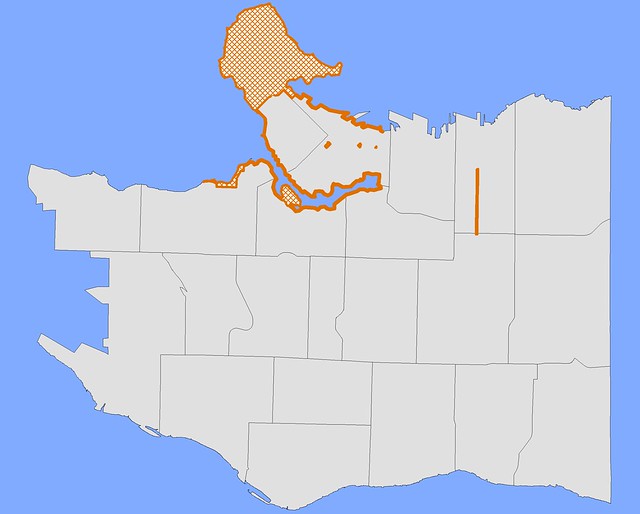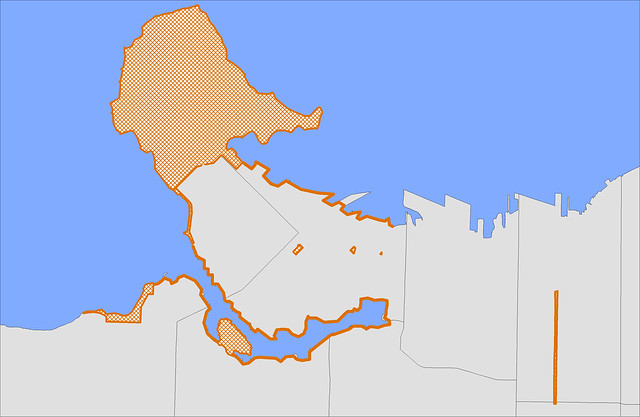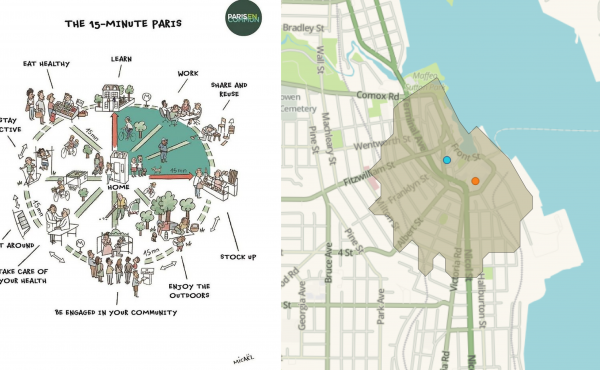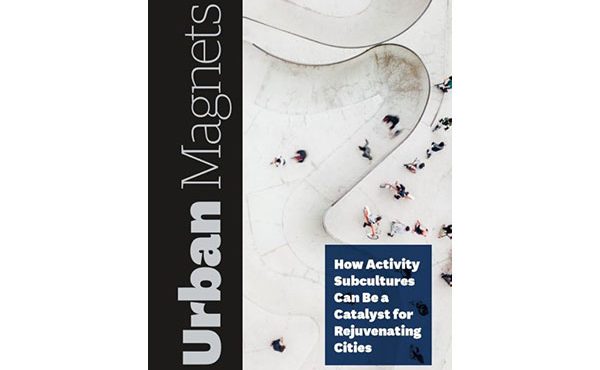
[The following is a transcript of the presentation given by Vancouver Public Space Network Chair Erin O’Melinn at the launch of the first national issue of Spacing magazine – and the roll-out of the Spacing Vancouver blog. Presenters were asked to respond to the top-ten best public spaces list contained in the magazine, while also linking the notion of public space to transportation planning. The story first appeared on the VPSN’s PubliCity blog.]
…So I looked at the Vancouver top ten public spaces in Vancouver as juried by Spacing Magazine (which just launched nation-wide!), and it immediately made me conjure up a mental map of where these spaces were located in this city. A few things struck me as a result.
The Spacing Magazine Top-10 List of Vancouver Public Spaces
-
Seawall
-
Granville Island
-
Stanley Park
-
Vancouver Art Gallery Stairs
-
Pioneer Place/Pigeon Park
-
Commercial Drive
-
English Bay First Beach
-
Victory Square
-
Kitsilao Beach Park
-
Robson Square
Why aren’t the spaces more spread across the city? This seems to be an useful point of departure for my presentation. I have come up with a few more questions as a response to this initial query.
Is it because the core is easy to get to and the rest of the city isn’t?
Access to areas by multiple modes is very important to creating a vibrant public space – all the successful ones have great transportation opportunities. Note the success of Granville Island. It is walkable from many people’s homes, you can access it by car, transit, bike, water taxi, private boat, and aquabus! Plus you feel safe on any of those modes there. Cars yield to wandering pedestrians, bikes connect directly to off-road facilities like the seawall, party yachts yield to the rainbow aquabusses. South of 16th transit gets less frequent, you have to bike uphill, and things are more spread out and less walkable.
Is it because people want a place to go to, a destination that isn’t in their own neighbourhood?
Sometimes the fun of a place is getting there, knowing you’re going somewhere in life (sometimes you have to take it literally if you’re not feeling it in the figurative sense). Perhaps part of the draw of good public places is it feels like an outing, not just wandering down the street. I often find myself seeking places that aren’t just out my front door, because I want something different from my everyday. Sometimes I like destinations where I know the experience of getting there is part of why I enjoy it – maybe it means I get to ride across the Burrard Bridge on my bike, maybe it means taking the bus along a busy commercial street and watching people run their errands. Maybe one of the reasons all our best public spaces are near the core is because those are also the trips that are the most fun along the way.
Is it because if people like public spaces to be full of lots of other people and activity, that might be something they actually want to avoid in the neighbourhood where they live?
I bet some people want to pick and choose when they have their exposure to the noise, unpredictability and mirth that public spaces can deliver. They probably don’t want us setting up a carnival band in their backyard. But I bet they’ll come downtown for the parade where that carnival band is marching.
Does this mean some people feel public spaces should be reserved for weekends?
Or other special occassions?
What kind of successful public spaces can and should be created in largely residential areas?
And what measures of success might we use to assess this?
What kind of successful public spaces already do exist there? I can think of a few: Queen E Park, the Fraser River walk, south Main…
But let’s get back to the top 10 we have here – they do cover off a number of what the VPSN would consider important components of public space such as connection to nature, places to sit and watch, areas of activity and commerce, and places that are easily visible and where there are lots of people. They tend to have good sun (or light as we experience more often here in Vancouver), and are easily accessed.
 None of the places just provide space. You rarely see groups hanging out in the middle of a flat plaza (for evidence, go hang out at the new Jack Poole Plaza where I’ve never seen anyone dare to sit or stand around). They tend toward the tree or the statue or the stairs – good public spaces usually don’t happen by accident – they need effort and investment and iterative response to how people interact with them, not just people are supposed to interact with them. Well-designed spaces strategically strike a balance between things that make us feel safe and welcome and things that let us push our normal habits: we want a sense of publicness where we know we belong, but we want to share it with people that are very different from ourselves; we want openness that allows us to people-watch, but we want a sense of enclosure so we don’t feel too watched ourselves; we want prolific transportation options to get there, but then we want to be buffered from fast moving traffic when we are there.
None of the places just provide space. You rarely see groups hanging out in the middle of a flat plaza (for evidence, go hang out at the new Jack Poole Plaza where I’ve never seen anyone dare to sit or stand around). They tend toward the tree or the statue or the stairs – good public spaces usually don’t happen by accident – they need effort and investment and iterative response to how people interact with them, not just people are supposed to interact with them. Well-designed spaces strategically strike a balance between things that make us feel safe and welcome and things that let us push our normal habits: we want a sense of publicness where we know we belong, but we want to share it with people that are very different from ourselves; we want openness that allows us to people-watch, but we want a sense of enclosure so we don’t feel too watched ourselves; we want prolific transportation options to get there, but then we want to be buffered from fast moving traffic when we are there.
So let’s talk Transportation. In the absence of robust public plazas in cities such as our lovely one, we often resort to the repurposing of transportation corridors, to meet these desires to be with each other en masse. We see events pop up like Car free festivals, summer spaces on Granville, the Olympics, the Pride and St patricks day and Santa Claus parades.
Streets can make fabulous people places but then where does mobility fit in? In Vancouver generally roads are “opened” for short periods of time. Everyone will forgive Santa or St Paddy for a day but are much less willing to give up a street for a summer or more to create a space for seating and interactivity for regular ol’ people. There are all sorts of barriers, for example, to opening up Robson Street between Hornby and Howe for public, non-motorized use in the long term and still maintain a level of mobility people are used to. The same goes for areas like Main St. or Commercial Drive, where Summer Spaces in 2009 were stopped early because businesses felt people couldn’t access them adequately.
We mentioned that access is very important – so how do we keep accessibility for all ages and abilities while enhancing public spaces? The closest I’ve gotten to an answer is: The priority shouldn’t be on how impacts to vehicular traffic can be minimized. The focus should be on how we’d like things to be in terms of vibrant public places, liveliness and the variety of ways to move people, not on the current state of transportation habits.
***



4 comments
My favourite public space is actually right outside my door, it’s Victoria Park, and it’s humming with activity all the time, even quite late despite the signs everyone ignores that say the park “closes” at 10 pm. It’s effectively my front yard, and I think there’s probably plenty of public spaces like this that wouldn’t make a map like this because they’re neighbourhood spaces where locals go but not places where people across the city go. I think that’s part of the reason that they don’t make this map, not that they aren’t wonderful spaces.
Hi Tessa,
I’m a big Victoria Park fan, as well. It was on the original list but not surprisingly turned out to be one of the hidden gems in Grandview-Woodlands. Maybe it’s better that way. 🙂
E
Commercial Drive? Why would this one be chosen over many other similar streets? Davie Street for instance.
Hi Miguel,
Great question! In fact, other similar streets (including Davie St. and others from around Metro Vancouver) were on the larger list of significant public spaces. At the end of the day, though, the jury had to filter their way down to a handful and the general feeling was that Commercial Dr. had a larger city-wide significance than some of the others that worked best at a neighbourhood scale. It was a tough decision making process given how many amazing and well-used local public spaces there are.
E